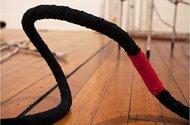Andrew Paul Wood – 17 October, 2009
In fact, it is so recognisably Indoors Rhodian that the style might be considered trademark – the careful alignments and groupings of objets trouvés (reminiscent, I’ve always felt, of the carefully-arranged-to-seem-random conglomerations used for still life drawing in high schools and art schools the world over), and the newsprint carefully foxed with delicate contagions of rust which wrap around the objects and hang on the walls.
Pauline Rhodes is a highly significant figure in New Zealand art and something of a doyen of Canterbury installation art with a practice covering four decades. She somehow manages to hover below the radar – yet at the same time her exhibitions are always striking.
Fluid Connections is rather typical of her recent work of the last decade – working and reworking a formal language that owes much to Louise Bourgeois and Joseph Beuys. In fact, it is so recognisably Indoors Rhodian that the style might be considered trademark – the careful alignments and groupings of objets trouvés (reminiscent, I’ve always felt, of the carefully-arranged-to-seem-random conglomerations used for still life drawing in high schools and art schools the world over), and the newsprint carefully foxed with delicate contagions of rust which wrap around the objects and hang on the walls.
The temporary and the Kristevan abject are present everywhere – plastic hosing, sticks, folding camp tables, and newspaper which provides many things with a skin. But this isn’t ordinary newspaper, but rather Le Monde Diplomatique, the Washington Post and the Guardian Weekly, providing only partly readable windows into global politics on both sides of the year 2000 (a similar trick to that frequently deployed by et al). The newspaper also provides a welcome lightening and confining element, which has a counterpoint in the minimalism of Rhodes’ outdoor installations, but also plays against the white walls of the gallery. Newspaper ultimately harkens back to modernist neutrality and the minimalist grid.
Rhodes’ oeuvre is founded in the 1960s and 1970s rejection of the hegemonic ‘rules’ of modernism, and a turning to the nature of materials, ephemerality, the time based, the space specific and personal enquiry. In a way I think that makes it delightfully old-fashioned in the sense that it rejects the interactive and electronic and is refreshingly honest to the historical origins of installation art.
Leaning against one wall white-painted logs seem to prop it up like a flying buttress, as if the installation had become architecturally one with the gallery space (one thinks of invasive nanotechnology gone rogue) while at the centre is a large water-filled black plastic container, papered on the outside. This forlorn ‘pond’ was deliberately encouraged to stagnate and scum over, and provides a kind of omphalos/cosmic navel to the whole dispersed composition. The rust and the scum, the nurtured weathering of objects, provide a connection to the outdoor environment and the natural world.
In some ways it is ironic (or paradoxical) that art like this that rejects commodification should be installed in a dealer gallery, but then of course we must keep in mind that Jonathan Smart is no ordinary gallerist. He very much likes to support contemporary practice with his gallery used as a venue as much as a salesroom. Fluid Connections is an example of the Rhodian intensum (her terminology) – an intensification of a space, as opposed to her outdoor works which are frequently extensums, or extensions of space.




 Advertising in this column
Advertising in this column Two Rooms presents a program of residencies and projects
Two Rooms presents a program of residencies and projects



This Discussion has 0 comments.
Comment
Participate
Register to Participate.
Sign in
Sign in to an existing account.